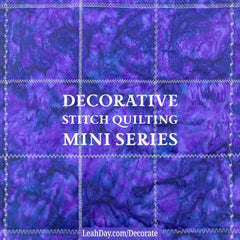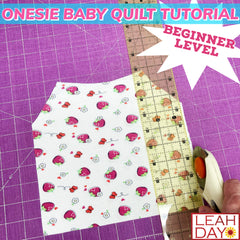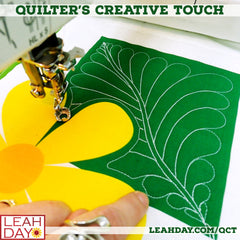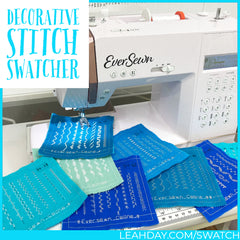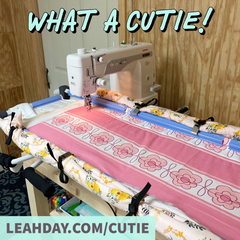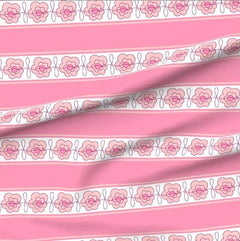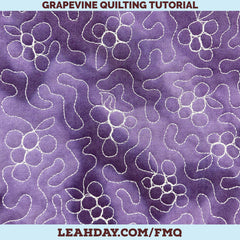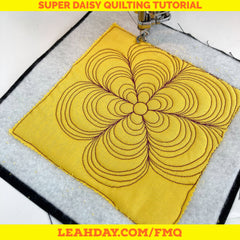Last week we pieced all the pieces of our Prism Path baby quilt together so this week it's time to plan and mark the quilting design on the surface so it's easy to quilt! Learn how to mark designs on your quilt top in this new quilting tutorial video:
Where do you find the instructions for piecing this pretty rainbow baby quilt? Find the cutting chart, diagrams, and everything you need to make your own Prism Path quilt in the book Explore Walking Foot Quilting with Leah Day.
Do I HAVE to Mark the Quilt Top???
You may be wondering if it’s a required step to mark your quilting designs on the quilt. No, definitely not. Many quilting designs don’t require any marking at all. We call these designs free hand because you quilt without marks to guide you.

But marking the quilt has many advantages. First off, you can see your quilting design clearly and be able to follow the lines. It sounds counter-intuitive, but this will speed up the quilting process because you don’t have to stop and think about the design or plan your next path through the quilt.
Think of this like the difference between walking on a beaten path in the woods. It’s easy. You don’t have to think about it because the path is already laid out in front of you. Quilting without marks is like tromping through the woods with no path. It’s easy to get lost and have to find your way back and that can take extra time.
The Most Important Step to Quilt Marking
Please, please, please do not miss this step - always TEST your marking pencil first before using it!
You need a marking pen that will create a solid, thin line that’s easy to follow as you quilt, but will wash out or erase off completely after the quilt is finished.

Please test your marking pen or pencil on a scrap of fabric first, then quilt on the lines, and erase any remaining marks following the instructions on the marking pen.
I marked the lighter version of Prism Path with the Fine Line Pen which washes out in water. This doesn’t mean spraying the quilt top with a bit of water on the surface. That will only disperse the pen marks, not erase them completely.
You will need to soak your quilt in water to remove these marks. This goes back to our lesson on preparing the fabrics before cutting. If you washed your fabric before cutting then it will be no problem to soak it to remove the marks at the end.

This is a picture of the Infinity Knot quilt being soaked in my bathtub after quilting. I fill the tub with lukewarm water and then submerge the quilt and let it set for around 20 minutes before letting the water out of the tub. Then I throw the quilt in the washer and spin out the water, then into the dryer for a quick tumble before it's ready for a snuggle.
So if you've had a bad experience with a water soluble pen, it might not have had anything to do with the pen, but how you were washing out the marks.

When marking the darker version of the Prism Path baby quilt I’ve just recently created, I used the Ceramic Marking Pencil. This pencil marks a thin white line that brushes off as you quilt. Any remaining traces of the marks can be removed with the eraser on the end of the pencil.
The one downside of this pencil is the more you handle the quilt, the greater the chance the marks will rub off and fade on the fabric. However, I’d rather have to re-mark a few sections than struggle with pencil marks that don’t remove.
This happened with my very first show quilt, The Duchess, and it was heartbreaking. Never use a marking pencil you’ve never used and never tested on a special quilt. If the marks are permanent, you will never get them off the surface.
Marking Straight Lines and Matrix
We’re quilting Prism Path baby quilt with two quilting designs: simple Straight Lines and Matrix, a wiggly grid design.
There are a lot of ways you can mark these designs on your quilt. I decided to let the piecing shapes guide me so I lined up the ruler through the Prism area running through the corners of each square.

When marking Matrix, I drew a wiggly line from the corners of the red or purple squares and carefully spaced the lines to create the curving grid. Make sure to watch the video to see how I planned and spaced the lines for Matrix.
There are many other ways you can space these lines. If you want more lines in the prism rainbow area, you can use the edges of your walking foot as a guide to stitch ½ inch on either side of the marked line. You could also stitch more lines perpendicular to the first set to turn the design into Gridlines.
In the background areas, you could also use the Matrix stencil to mark this curving design continuously through the space. Adding more lines will add more time to the baby quilt project, but it will also add more thread and more security to the layers of the quilt.
The more quilting your quilt has, the longer it will last.
Prism Path Quilting Homework
Your homework this week is to mark your Prism Path baby quilt top with straight lines and Matrix. By marking the designs it will feel so much easier to quilt this quilt over the next two weeks.
You'll also need to baste your quilt top with batting and backing fabric. If you're needing tips on basting, check out the Basting Basics Workshop to learn more about the basting process.
I love using flower pins and Pinmoors for basting (unfortunately no longer available) because they're easy and fast to insert and also easy to remove while quilting.
Remember, you can find all of the piecing and cutting instructions in the book Explore Walking Foot Quilting with Leah Day.
Let's go quilt,
Leah Day
Find all of the posts for this baby quilt along by clicking the images below:



